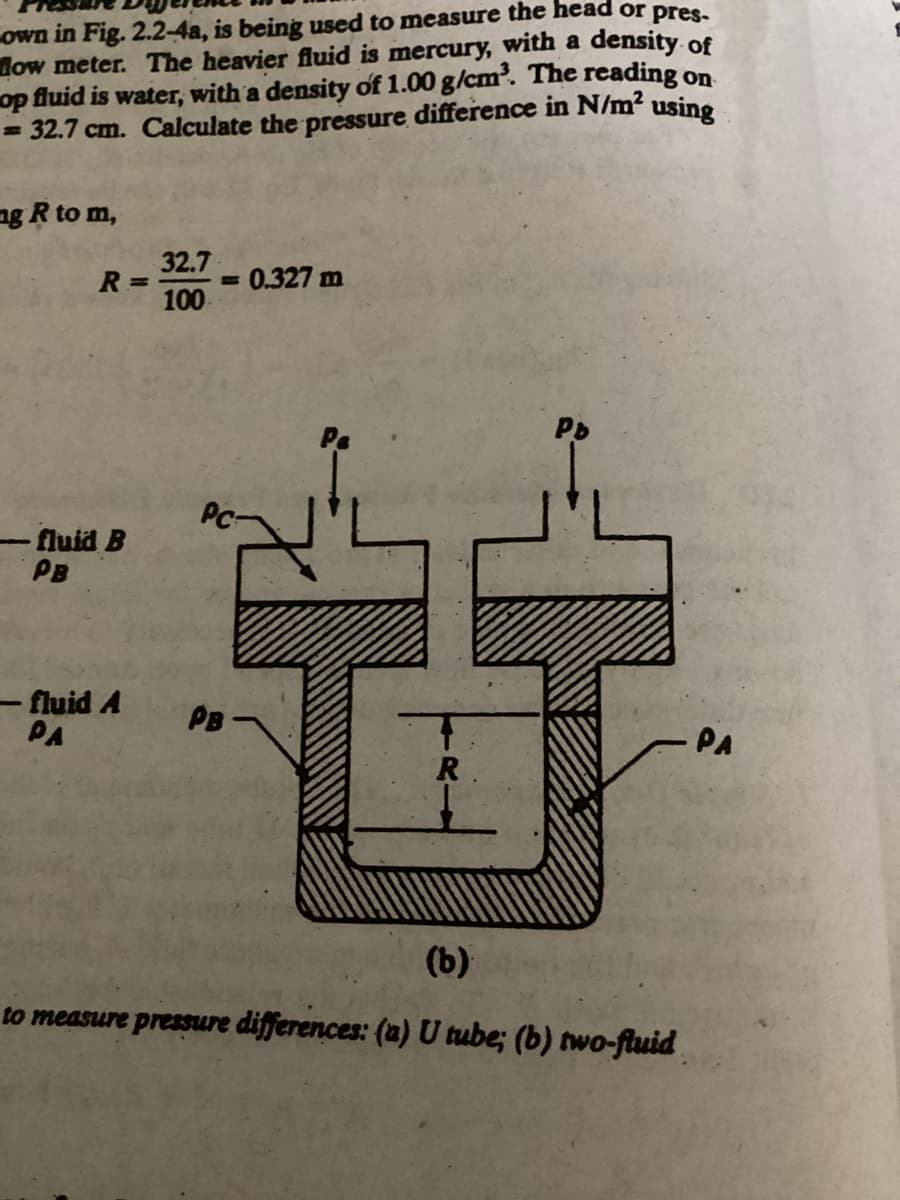Derive the diagram to this equation 2.2-15
Elements Of Electromagnetics
7th Edition
ISBN:9780190698614
Author:Sadiku, Matthew N. O.
Publisher:Sadiku, Matthew N. O.
ChapterMA: Math Assessment
Section: Chapter Questions
Problem 1.1MA
Related questions
Question
Derive the diagram to this equation 2.2-15

Transcribed Image Text:own in Fig. 2.2-4a, is being used to measure the head or pres-
How meter. The heavier fluid is mercury, with a density of
op fluid is water, with a density of 1.00 g/cm³. The reading on
= 32.7 cm. Calculate the pressure difference in N/m² using
mg R to m,
R =
-fluid B
PB
- fluid A
PA
32.7
100
M
= 0.327 m
PB-
tay
R.
Pb
(b)
to measure pressure differences: (a) U tube; (b) two-fluid
PA

Transcribed Image Text:2. Two-fluid U tube. In Fig. 2.2-4b a two-fluid U tube is shown, which is a sensitive device
for measuring small heads or pressure differences. Let A m² be the cross-sectional area of
each of the large reservoirs and a m² be the cross-sectional area of each of the tubes forming
the U. Proceeding and making a pressure balance as for the U tube,
a
a
R - RO) (P₁ - PB + PB - PC) 8
Pc
PaPb (R- RO) PA
(2.2-15)
where Ro is the reading when p. = Pb, R is the actual reading, PA is the density of the heavier
fluid, and PB
is the density of the lighter fluid. Usually, a/A is made sufficiently small as to be
negligible, and also Ro is often adjusted to zero; then
Pa- Pb = R(PA-PB)8
(SI)
(22-10
Expert Solution
This question has been solved!
Explore an expertly crafted, step-by-step solution for a thorough understanding of key concepts.
Step by step
Solved in 3 steps with 4 images

Knowledge Booster
Learn more about
Need a deep-dive on the concept behind this application? Look no further. Learn more about this topic, mechanical-engineering and related others by exploring similar questions and additional content below.Recommended textbooks for you

Elements Of Electromagnetics
Mechanical Engineering
ISBN:
9780190698614
Author:
Sadiku, Matthew N. O.
Publisher:
Oxford University Press

Mechanics of Materials (10th Edition)
Mechanical Engineering
ISBN:
9780134319650
Author:
Russell C. Hibbeler
Publisher:
PEARSON

Thermodynamics: An Engineering Approach
Mechanical Engineering
ISBN:
9781259822674
Author:
Yunus A. Cengel Dr., Michael A. Boles
Publisher:
McGraw-Hill Education

Elements Of Electromagnetics
Mechanical Engineering
ISBN:
9780190698614
Author:
Sadiku, Matthew N. O.
Publisher:
Oxford University Press

Mechanics of Materials (10th Edition)
Mechanical Engineering
ISBN:
9780134319650
Author:
Russell C. Hibbeler
Publisher:
PEARSON

Thermodynamics: An Engineering Approach
Mechanical Engineering
ISBN:
9781259822674
Author:
Yunus A. Cengel Dr., Michael A. Boles
Publisher:
McGraw-Hill Education

Control Systems Engineering
Mechanical Engineering
ISBN:
9781118170519
Author:
Norman S. Nise
Publisher:
WILEY

Mechanics of Materials (MindTap Course List)
Mechanical Engineering
ISBN:
9781337093347
Author:
Barry J. Goodno, James M. Gere
Publisher:
Cengage Learning

Engineering Mechanics: Statics
Mechanical Engineering
ISBN:
9781118807330
Author:
James L. Meriam, L. G. Kraige, J. N. Bolton
Publisher:
WILEY